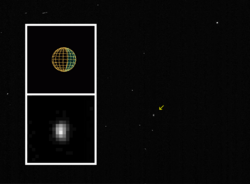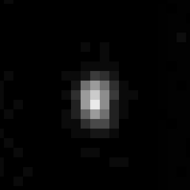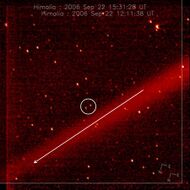Astronomy:Himalia (moon)
 Himalia as seen by spacecraft Cassini | |
| Discovery [1] | |
|---|---|
| Discovered by | Charles D. Perrine |
| Discovery site | Lick Observatory |
| Discovery date | 3 December 1904 |
| Designations | |
Designation | Jupiter VI |
| Pronunciation | /hɪˈmeɪliə/ or /hɪˈmɑːliə/[2] |
| Named after | Ἱμαλία Himalia |
| Adjectives | Himalian[3] |
| Orbital characteristics [4] | |
| Epoch 27 April 2019 (JD 2458600.5) | |
| Observation arc | 114.25 yr (41,728 days) |
| 0.0761287 astronomical unit|AU (11,388,690 km) | |
| Eccentricity | 0.1537860 |
| Orbital period | +248.29 d |
| Mean anomaly | 94.30785° |
| Mean motion | 1° 26m 59.616s / day |
| Inclination | 29.90917° (to the ecliptic) |
| Longitude of ascending node | 44.99935° |
| 21.60643° | |
| Satellite of | Jupiter |
| Group | Himalia group |
| Physical characteristics | |
| Dimensions | 205.6 × 141.4 km (occultation, projected)[5] 150±20 × 120±20 km (Cassini estimate)[6] |
| Mean diameter | 139.6±1.7 km[7] |
| Mass | (4.2±0.6)×1018 kg[8] |
| Mean density | 1.63 g/cm3 (assuming radius 85 km)[8][lower-alpha 1] |
| ~ 0.062 m/s2 (0.006 g) | |
| ~ 0.100 km/s | |
| Rotation period | 7.7819±0.0005 h[9] |
| Albedo | 0.057±0.008[7] |
Spectral type | C[7] |
| Apparent magnitude | 14.6[10] |
| Absolute magnitude (H) | 7.9[4] |
Himalia (/hɪˈmeɪliə, hɪˈmɑːliə/), or Jupiter VI, is the largest irregular satellite of Jupiter, with a diameter of at least 140 km (90 mi).[5] It is the sixth largest Jovian satellite, after the four Galilean moons and Amalthea. It was discovered by Charles Dillon Perrine at the Lick Observatory on 3 December 1904 and is named after the nymph Himalia, who bore three sons of Zeus (the Greek equivalent of Jupiter).[1] It is one of the largest planetary moons in the Solar System not imaged in detail, and the third largest not imaged in detail within the orbit of Neptune.[lower-alpha 2]
Discovery
Himalia was discovered by Charles Dillon Perrine at the Lick Observatory on 3 December 1904 in photographs taken with the 36-inch Crossley reflecting telescope which he had recently rebuilt.[1] Himalia is Jupiter's most easily observed small satellite; though Amalthea is brighter, its proximity to the planet's brilliant disk makes it a far more difficult object to view.[11][12]
Name
Himalia is named after the nymph Himalia, who bore three sons of Zeus (the Greek equivalent of Jupiter). The moon did not receive its present name until 1975;[13] before then, it was simply known as Jupiter VI or Jupiter Satellite VI, although calls for a full name appeared shortly after its and Elara's discovery; A.C.D. Crommelin wrote in 1905:
| “ | Unfortunately the numeration of Jupiter's satellites is now in precisely the same confusion as that of Saturn's system was before the numbers were abandoned and names substituted. A similar course would seem to be advisable here; the designation V for the inner satellite [Amalthea] was tolerated for a time, as it was considered to be in a class by itself; but it has now got companions, so that this subterfuge disappears. The substitution of names for numerals is certainly more poetic.[14] | ” |
The moon was sometimes called Hestia, after the Greek goddess, from 1955 to 1975.[15]
Orbit
At a distance of about 11,400,000 km (7,100,000 mi) from Jupiter, Himalia takes about 250 Earth days to complete one orbit around Jupiter.[16] It is the largest member of the Himalia group, which are a group of small moons orbiting Jupiter at a distance from 11,400,000 km (7,100,000 mi) to 13,000,000 km (8,100,000 mi), with inclined orbits at an angle of 27.5 degrees to Jupiter's equator.[17] Their orbits are continuously changing due to solar and planetary perturbations.[18]
Physical characteristics


Himalia's rotational period is 7 h 46 m 55±2 s.[9] Himalia appears neutral in color (grey), like the other members of its group, with colour indices B−V=0.62, V−R=0.4, similar to a C-type asteroid.[19] Measurements by Cassini confirm a featureless spectrum, with a slight absorption at 3 μm, which could indicate the presence of water.[20] Although Himalia is the sixth-largest moon of Jupiter, it is the fifth-most massive. Amalthea is only a few km bigger, but less massive. Resolved images of Himalia by Cassini have led to a size estimate of 150 km × 120 km (93 mi × 75 mi), while ground-based estimates suggest that Himalia is large, with a diameter around 170 km (110 mi).[6][10] In May 2018, Himalia occulted a star, allowing for precise measurements of its size.[5] The occultation was observed from the United States state of Georgia.[5] From the occultation, Himalia was given a size estimate of 205.6 km × 141.3 km (127.8 mi × 87.8 mi), in agreement with earlier ground-based estimates.[5]
Mass
In 2005, Emelyanov estimated Himalia to have a mass of (4.2±0.6)×1018 kg (GM=0.28±0.04), based on a perturbation of Elara on July 15, 1949.[8] JPL's Solar System dynamics web site assumes that Himalia has a mass of 2.3×1018 kg (GM=0.15) with a radius of 85 km.[10]
Himalia's density will depend on whether it has an average radius of about 67 km (geometric mean from Cassini)[8] or a radius closer to 85 km.[10]
| Source | Radius km |
Density g/cm3 |
Mass kg |
|---|---|---|---|
| Emelyanov | 67 | 3.33 | 4.2×1018 |
| Emelyanov | 85 | 1.63[lower-alpha 1] | 4.2×1018 |
| JPL SSD | 85 | 0.88 | 2.3×1018 |
Exploration
In November 2000, the Cassini spacecraft, en route to Saturn, made a number of images of Himalia, including photos from a distance of 4.4 million km. Himalia covers only a few pixels, but seems to be an elongated object with axes 150±20 and 120±20 km, close to the Earth-based estimations.[6]
In February and March 2007, the New Horizons spacecraft en route to Pluto made a series of images of Himalia, culminating in photos from a distance of 8 million km. Again, Himalia appears only a few pixels across.[21]
Himalia ring
In September 2006, as NASA's New Horizons mission to Pluto approached Jupiter for a gravity assist, it photographed what appeared to be a faint new planetary ring parallel with and slightly inside Himalia's orbit. Because the small (4-km) moon Dia, which had a similar orbit to Himalia, had gone missing since its discovery in 2000, there was some speculation that the ring could be debris from an impact of Dia into Himalia, suggesting that Jupiter continued to gain and lose small moons through collisions.[22] However, an impact by an object the size of Dia would produce far more material than the calculated amount of ejected material needed to form the ring, although it is possible that a smaller, unknown moon may have been involved instead.[23] The recovery of Dia in 2010 and 2011 disproved any connection between Dia and the Himalia ring.[24][25]
Notes
- ↑ 1.0 1.1 Density = GM / G / (Volume of a sphere of 85km) = 1.63 g/cm3
- ↑ It is the largest with the exception of Sycorax and Puck orbiting Uranus, some of the moons of Neptune and several trans-Neptunian objects, particularly Dysnomia, the moon of Eris. List of natural satellites
See also
References
- ↑ 1.0 1.1 1.2
Porter, J.G. (1905). "Discovery of a Sixth Satellite of Jupiter". Astronomical Journal 24 (18): 154B. doi:10.1086/103612. Bibcode: 1905AJ.....24..154P.;
Perrine, C.D. (1905-01-25). "Sixth Satellite of Jupiter Confirmed". Harvard College Observatory Bulletin 175: 1. Bibcode: 1905BHarO.175....1P.;
Perrine, C.D. (1905). "Discovery of a Sixth Satellite to Jupiter". Publications of the Astronomical Society of the Pacific 17 (100): 22–23. doi:10.1086/121619. Bibcode: 1905PASP...17...22..;
Perrine, C.D. (1905). "Orbits of the sixth and seventh satellites of Jupiter". Astronomische Nachrichten 169 (3): 43–44. doi:10.1002/asna.19051690304. Bibcode: 1905AN....169...43P. https://zenodo.org/record/1424813. - ↑ Daintith & Gould (2006) The Facts on File Dictionary of Astronomy, p. 216
- ↑ Yenne (1987) The Atlas of the Solar System.
- ↑ 4.0 4.1 "M.P.C. 115889". Minor Planet Circular. Minor Planet Center. 27 August 2019. https://minorplanetcenter.net/iau/ECS/MPCArchive/2019/MPC_20190827.pdf.
- ↑ 5.0 5.1 5.2 5.3 5.4 "Jupiter (06) Himalia". 12 May 2018. http://www.asteroidoccultation.com/observations/Results/Data2018/20180512%20P5M06%20HimaliaProfile.gif.
- ↑ 6.0 6.1 6.2 Porco, Carolyn C. (March 2003). "Cassini Imaging of Jupiter's Atmosphere, Satellites, and Rings". Science 299 (5612): 1541–1547. doi:10.1126/science.1079462. PMID 12624258. Bibcode: 2003Sci...299.1541P. https://www.researchgate.net/publication/10867818.
- ↑ 7.0 7.1 7.2 Grav, T.Expression error: Unrecognized word "etal". (August 2015). "NEOWISE: Observations of the Irregular Satellites of Jupiter and Saturn". The Astrophysical Journal 809 (1): 9. doi:10.1088/0004-637X/809/1/3. 3. Bibcode: 2015ApJ...809....3G.
- ↑ 8.0 8.1 8.2 8.3 Emelyanov, N.V. (2005). "The mass of Himalia from the perturbations on other satellites". Astronomy and Astrophysics 438 (3): L33–L36. doi:10.1051/0004-6361:200500143. Bibcode: 2005A&A...438L..33E. https://www.aanda.org/articles/aa/pdf/2005/30/aahe201.pdf.
- ↑ 9.0 9.1 9.2 Pilcher, Frederick; Mottola, Stefano; Denk, Tilmann (2012). "Photometric lightcurve and rotation period of Himalia (Jupiter VI)". Icarus 219 (2): 741–742. doi:10.1016/j.icarus.2012.03.021. Bibcode: 2012Icar..219..741P.
- ↑ 10.0 10.1 10.2 10.3 "Planetary Satellite Physical Parameters". Jet Propulsion Laboratory. https://ssd.jpl.nasa.gov/sats/phys_par/. Retrieved 2022-03-28.
- ↑ "Himalia, Jupiter's "fifth" moon". October 2009. http://www.biophysik.uni-freiburg.de/Reiner/ATM/artikel/Himalia_e.html.
- ↑ Rick Scott (October 20, 2003). "Finding Himalia, The Fifth Brightest Moon Of Jupiter". http://www.astronomy.net/articles/18/.
- ↑ Marsden, B. G. (7 October 1975). "IAUC 2846: N Mon 1975 (= A0620-00); N Cyg 1975; 1975h; 1975g; 1975i; Sats OF JUPITER". IAU. http://www.cbat.eps.harvard.edu/iauc/02800/02846.html.
- ↑ Crommelin, A. C. D. (March 10, 1905). "Provisional Elements of Jupiter's Satellite VI". Monthly Notices of the Royal Astronomical Society 65 (5): 524–527. doi:10.1093/mnras/65.5.524. Bibcode: 1905MNRAS..65..524C.
- ↑ Payne-Gaposchkin, Cecilia; Katherine Haramundanis (1970). Introduction to Astronomy. Englewood Cliffs, N.J.: Prentice-Hall. ISBN 978-0-13-478107-5.
- ↑ "Himalia". NASA. December 5, 2017. https://solarsystem.nasa.gov/moons/jupiter-moons/himalia/in-depth/.
- ↑ Jewitt, David C.; Sheppard, Scott; Porco, Carolyn (2004). "Jupiter's Outer Satellites and Trojans". in Bagenal, Fran. Jupiter: The planet, Satellites and Magnetosphere. Cambridge University Press. http://www.dtm.ciw.edu/users/sheppard/pub/Sheppard04JupChapter.pdf.
- ↑ Jacobson, R. A. (2000). "The orbits of outer Jovian satellites". Astronomical Journal 120 (5): 2679–2686. doi:10.1086/316817. Bibcode: 2000AJ....120.2679J. https://trs.jpl.nasa.gov/bitstream/2014/15175/1/00-1187.pdf.
- ↑ Rettig, T. W.; Walsh, K.; Consolmagno, G. (December 2001). "Implied Evolutionary Differences of the Jovian Irregular Satellites from a BVR Color Survey". Icarus 154 (2): 313–320. doi:10.1006/icar.2001.6715. Bibcode: 2001Icar..154..313R.
- ↑ Chamberlain, Matthew A.; Brown, Robert H. (2004). "Near-infrared spectroscopy of Himalia". Icarus 172 (1): 163–169. doi:10.1016/j.icarus.2003.12.016. Bibcode: 2004Icar..172..163C.
- ↑ Lakdawalla, E. (1 March 2007). "The Bruce Murray Space Image Library – Jupiter's moon Himalia". http://www.planetary.org/multimedia/space-images/jupiter/himalia.html.
- ↑ "Lunar marriage may have given Jupiter a ring". New Scientist. March 20, 2010. p. 16. https://www.newscientist.com/article/mg20527523.400-lunar-marriage-may-have-given-jupiter-a-ring.html.
- ↑ Cheng, A. F.; Weaver, H. A.; Nguyen, L.; Hamilton, D. P.; Stern, S. A.; Throop, H. B. (March 2010). "A New Ring or Ring Arc of Jupiter?". 41st Lunar and Planetary Science Conference. Lunar and Planetary Institute. p. 2549. Bibcode: 2010LPI....41.2549C. https://www.lpi.usra.edu/meetings/lpsc2010/pdf/2549.pdf.
- ↑ Gareth V. Williams (2012-09-11). "MPEC 2012-R22 : S/2000 J 11". Minor Planet Center. http://www.minorplanetcenter.net/mpec/K12/K12R22.html.
- ↑ "Long Lost Moon of Jupiter Found". May 13, 2013. https://dtm.carnegiescience.edu/news/long-lost-moon-jupiter-found.
External links
- "Himalia: Overview" by NASA's Solar System Exploration
- David Jewitt pages
- Jupiter's Known Satellites (by Scott S. Sheppard)
- Two Irregular Satellites of Jupiter (Himalia & Elara: Remanzacco Observatory: November 23, 2012)
 |





